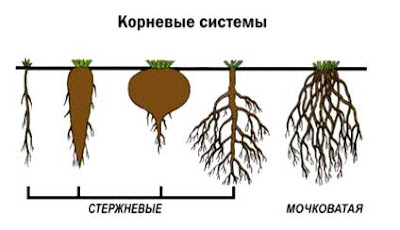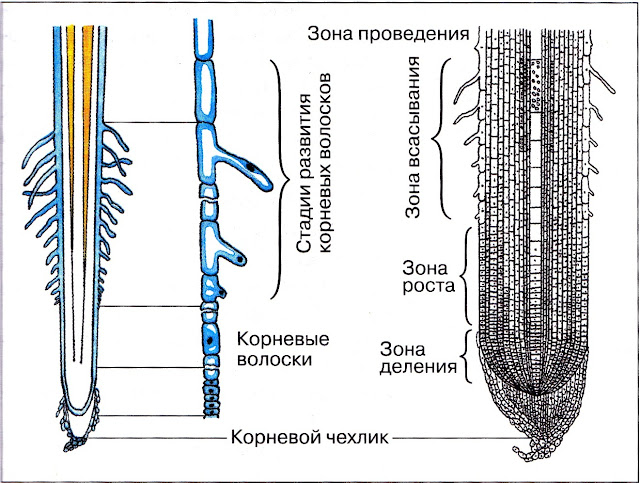Plant roots. Root system types. Root functions. Root zones. Modification of roots.
Questions:
1.Root functions
2.Species of roots
3.Types of root system
4 root zones
5. Modification of roots
6 vital processes at the root
1. Root functions
Root Is an underground organ of a plant.
The main functions of the root:
- supporting: the roots fix the plant in the soil and hold it throughout its life;
- nutritious: through the roots the plant receives water with dissolved mineral and organic substances;
- storing: nutrients can accumulate in some roots.
2. Types of roots
Distinguish between main, adventitious and lateral roots. When the seed germinates, the embryonic root appears first, which turns into the main one. Adventitious roots may appear on the stems. Lateral roots extend from the main and adventitious roots. The adventitious roots provide the plant with additional nutrition and perform a mechanical function. They develop when hilling, for example, tomatoes and potatoes.
3. Types of root system
The roots of one plant are the root system. The root system is pivotal and fibrous. In the tap root system, the main root is well developed. Most dicotyledonous plants (beets, carrots) have it. In perennial plants, the main root can die off, and nutrition occurs at the expense of lateral roots, so the main root can only be traced in young plants.
The fibrous root system is formed only by adventitious and lateral roots. There is no main root in it. Monocotyledonous plants have such a system, for example, cereals, onions.
Root systems take up a lot of space in the soil. For example, in rye, the roots spread 1-1.5 m in breadth and penetrate up to 2 m in depth.

4. Root zones
In a young root, the following zones can be distinguished: root cap, division zone, growth zone, suction zone.

Root cap has a darker color, this is the very tip of the root. Root cap cells protect the root apex from damage by solid soil particles. The cap cells are formed by the integumentary tissue and are constantly renewed.
Suction zone has many root hairs, which are elongated cells no more than 10 mm long. This area looks like a cannon, because root hairs are very small. Root hair cells, like other cells, have a cytoplasm, a nucleus, and vacuoles with cell sap. These cells are short-lived, die off quickly, and in their place new ones are formed from the younger superficial cells located closer to the root tip. The task of the root hairs is to absorb water with dissolved nutrients. The suction zone is constantly moving due to cell renewal. It is delicate and easily damaged when transplanted. The cells of the underlying tissue are present here.
Zone ... It is located above the suction, does not have root hairs, the surface is covered with integumentary tissue, and there is a conductive tissue in the thickness. The cells of the conduction zone are vessels through which water with solutes moves to the stem and leaves. There are also vascular cells through which organic matter from the leaves enters the root.
The entire root is covered with mechanical tissue cells, which ensures the strength and elasticity of the root. The cells are elongated, covered with a thick membrane and filled with air.
5. Modification of rootsThe depth of root penetration into the soil depends on the conditions in which the plants are found. The length of the roots is influenced by moisture, soil composition, permafrost.
Long roots are formed in plants in arid places. This is especially true for desert plants. So in a camel thorn, the root system reaches 15-25 m in length. In wheat in non-irrigated fields, the roots reach 2.5 m in length, and in irrigated fields - 50 cm, and their density increases.
Permafrost limits the growth of roots in depth. For example, in the tundra, a dwarf birch has only 20 cm roots. The roots are shallow and branched.
In the process of adapting to environmental conditions, the roots of plants have changed and began to perform additional functions.
1. Root tubers act as a store of nutrients instead of fruits. Such tubers appear as a result of thickening of lateral or adventitious roots. For example, dahlias.
2. Root crops - modifications of the main root in such plants as carrots, turnips, beets. Root crops are formed by the lower part of the stem and the upper part of the main root. Unlike fruits, they do not have seeds. Root crops have biennial plants. In the first year of life, they do not bloom and accumulate many nutrients in root crops. On the second, they bloom quickly, using accumulated nutrients and form fruits and seeds.
3. Attachment roots (suckers) - adventitious measles that develop in plants in tropical places. They allow you to attach to vertical supports (to a wall, rock, tree trunk), bringing foliage to the light. An example would be ivy and clematis.
4. Bacterial nodules. The lateral roots of clover, lupine, and alfalfa are peculiarly changed. Bacteria settle in the young lateral roots, which facilitates the assimilation of gaseous nitrogen in the soil air. Such roots take the form of nodules. Thanks to these bacteria, these plants are able to live in nitrogen-poor soils and make them more fertile.
5. Aerial roots are formed in plants growing in humid equatorial and tropical forests. Such roots hang down and absorb rainwater from the air - they are found in orchids, bromeliads, some ferns, and monstera.
Aerial support roots are adventitious roots that form on tree branches and reach the ground. Occur in banyan, ficus.
6. Stilted roots. Plants growing in the intertidal zone develop stilted roots. They hold large leafy shoots high above the water on unsteady muddy ground.
7. Respiratory roots are formed in plants that do not have enough oxygen to breathe. Plants grow in excessively humid places - in swampy swamps, creeks, sea estuaries. The roots grow vertically upward and emerge to the surface, absorbing air. Examples include brittle willow, marsh cypress, mangrove forests.

6. Life processes at the root
1 - Absorption of water by roots
The absorption of water by root hairs from the soil nutrient solution and its conduction through the cells of the primary cortex occurs due to the difference in pressure and osmosis. Osmotic pressure in the cells forces minerals to enter the cells. their salt content in them is less than in the soil. The rate at which the root hairs absorb water is called the suction force. If the concentration of substances in the soil nutrient solution is higher than inside the cell, then the water will leave the cells and plasmolysis will occur - the plants will wither. This phenomenon is observed in dry soil conditions, as well as with excessive application of mineral fertilizers. Root pressure can be confirmed by a series of experiments.
The plant with roots is dipped into a glass of water. Pour a thin layer of vegetable oil over the water to protect it from evaporation and mark the level. After a day or two, the water in the container dropped below the mark. Therefore, the roots sucked in the water and brought it up to the leaves.
Purpose: to find out the main function of the root.
Cut off the stem of the plant, leaving a stump 2-3 cm high. Put a rubber tube 3 cm long on the stump, and put a curved glass tube 20-25 cm high on the upper end. The water in the glass tube rises and flows out. This proves that the root absorbs water from the soil into the stem.
Purpose: to find out how temperature affects the functioning of the root.
One glass should be with warm water (+ 17-18 ° C), and the other with cold (+ 1-2 ° C). In the first case, water is released abundantly, in the second - little, or completely stops. This is proof that temperature has a profound effect on the functioning of the root.
Warm water is actively absorbed by the roots. Root pressure rises.
Cold water is poorly absorbed by the roots. In this case, the root pressure drops.
2 - Mineral nutrition
The physiological role of minerals is very important. They are the basis for the synthesis of organic compounds and directly affect the metabolism; serve as catalysts for biochemical reactions; affect cell turgor and protoplasm permeability; are the centers of electrical and radioactive phenomena in plant organisms. With the help of the root, the mineral nutrition of the plant is carried out.
3 - Breathing roots
For normal growth and development of the plant, it is necessary that fresh air flows to the root.
Purpose: to check the presence of respiration at the roots.
Let's take two identical vessels with water. We will place developing seedlings in each vessel. We saturate the water in one of the vessels with air every day using a spray bottle. Pour a thin layer of vegetable oil on the surface of the water in the second vessel, as it delays the flow of air into the water. After a while, the plant in the second vessel will stop growing, wither, and eventually die. The death of the plant occurs due to the lack of air necessary for the respiration of the root.
It has been established that the normal development of plants is possible only if the nutrient solution contains three substances - nitrogen, phosphorus and sulfur and four metals - potassium, magnesium, calcium and iron. Each of these elements has an individual meaning and cannot be replaced by another. These are macronutrients, their concentration in the plant is 10-2-10%. For the normal development of plants, microelements are needed, the concentration of which in the cell is 10-5-10-3%. These are boron, cobalt, copper, zinc, manganese, molybdenum, etc. All these elements are present in the soil, but sometimes in insufficient quantities. Therefore, mineral and organic fertilizers are applied to the soil.
The plant grows and develops normally if all the necessary nutrients are contained in the environment surrounding the roots. Soil is such a medium for most plants.







